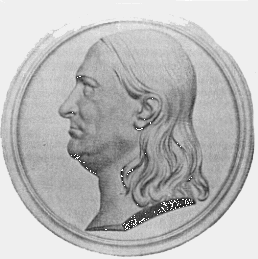

|
|
|
|
|
|
|
|
|
The Discovery and Isolation of Caffeine
Caffeine has been used as a medicinal and recreational drug since before recorded history, by consumption of caffeine bearing plants. However, the discovery of the chemical did not occur until a young physician called Friedlieb Ferdinand Runge isolated and purified the white crystalline substance in 1819.

A bronze memorial medallion of Runge
erected at his grave site.
The breakthrough is credited to an encounter between twenty-five year old Runge and a German baron known as Johann Wolfgang von Goethe. Goethe was one of the world's greatest poets, and Europe's first great literary celebrity¹. In his later years, Goethe turned his considerable intellect to the sciences, studying, amongst other things, pharmacy, chemistry and botany. At the time, Runge was studying under the chemist Doebereiner (1780-1849), who was greatly admired by Goethe; it was through the friendship and mutual admiration of these two great men that Runge was invited to visit.
Goethe was shown the results of the young scientist's investigations into belladonna extract, and, suitably impressed, presented Runge with a small box of rare Arabian mocha beans, with the request that he perform an analysis. Within months Runge had successfully isolated the world's first pure caffeine sample.
Runge's discovery lead to a brilliant career in purine chemistry, with sources suggesting he was also the first to discover quinine, a feat which is (possibly erroneously) credited to Pelletier (1788-1842) and Caventou (1795-1877) in other sources. In 1833 he synthesised aniline blue, the first artificial organic colouring produced from coal tar, and was a pioneer in the technique of paper chromatography.
Sadly, in 1852, Runge was dismissed from his job when the new owner of the company failed to agree with his suggestions for further developments. He died in poverty and relative obscurity in 1867, although the German Chemical Society erected the memorial (above) in 1873 to recognise his achievements.
As Weinberg and Bealer state in their book 'The
World Of Caffeine', "it was a result of an encounter between a scientist
and a poet that caffeine was first revealed to the world; a curiously symbolic
origin when one considers the vast panorama of the drug's history, encompassing,
as it does, so much of the disparate worlds of science and culture."
¹The World of Caffeine, Weinberg and Bealer, Routledge, 2001
Image used without permission from
the following source:
The World of Caffeine, Weinberg
and Bealer, Routledge, 2001